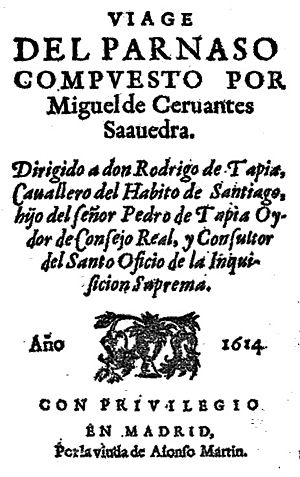Viaje del Parnaso facts for kids
Viaje del Parnaso ("Journey to Parnassus") is a long poem by Miguel de Cervantes. It was first published in 1614. This was just two years before Cervantes passed away.
Contents
What is Viaje del Parnaso About?
This poem is mostly about Spanish poets from Cervantes' time. They gather on a make-believe boat heading to Mount Parnassus. This mountain was believed to be the home of the Greek god Apollo and the Muses. Cervantes uses humor to talk about these poets. He sometimes makes fun of those he thinks are not good enough.
Cervantes himself said that poets not mentioned in the poem should be happy. This shows his playful way of writing. He wanted to show what true poetry was like. He also wanted to share his love for poetry, even in his old age. The poem also helps people who just make rhymes without real meaning to see their mistakes. It mixes hidden jokes with open humor.
How is the Poem Structured?
The poem has eight chapters. It is written in a special verse style called tercets. This means each stanza has three lines. The story is both funny and serious at the same time.
Many funny things happen in the poem. The god Mercury appears to Cervantes. Cervantes is shown traveling to Parnassus in a very poor state. Mercury greets him as the "Adam of poets." Mercury praises Cervantes a lot. Then, he takes Cervantes to a ship. This ship is built from different kinds of poetry. It is meant to carry Spanish poets to Apollo's kingdom. The description of the ship is a funny story with a hidden meaning.
Mercury shows Cervantes a list of poets that Apollo wants to meet. This list has caused problems for people studying the poem. This is because the praises are sometimes serious and sometimes ironic. While reading, Cervantes suddenly drops the list.
Adventures on the Journey
The poets then crowd onto the ship. There are so many of them, like raindrops or grains of sand. It causes such a big fuss that the sirens create a huge storm. This is to stop the ship from sinking under their weight. The story gets even wilder as it goes on.
The storm calms down. Then, poets start falling from the clouds like rain. One of the first to land on the ship is Lope de Vega. Cervantes takes this chance to praise Lope de Vega strongly. The rest of the poem continues with the same mix of humor and adventure.
Gods and Battles
Cervantes also describes the goddess Poesy. He sees her in all her glory in Apollo's kingdom. Later, the goddess Vain-Glory appears to him in a dream. This picture of Vain-Glory is a funny contrast to Poesy.
One very funny part, like Don Quixote, describes a second storm. In this storm, Neptune tries to sink the bad poets. But Venus saves them. She turns them into gourds and leather flasks. Finally, a big battle happens. It is fought between the real poets and some of the bad poets.
The poem is full of clever and witty ideas. Only a few parts are not as good as the rest. This poem was unique and had no other work like it before. The language used is classic and proper. Cervantes also added a funny prose part to the poem. In this part, he praises his own writing skills.
See also
- 1614 in poetry
 In Spanish: Viaje del Parnaso para niños
In Spanish: Viaje del Parnaso para niños


